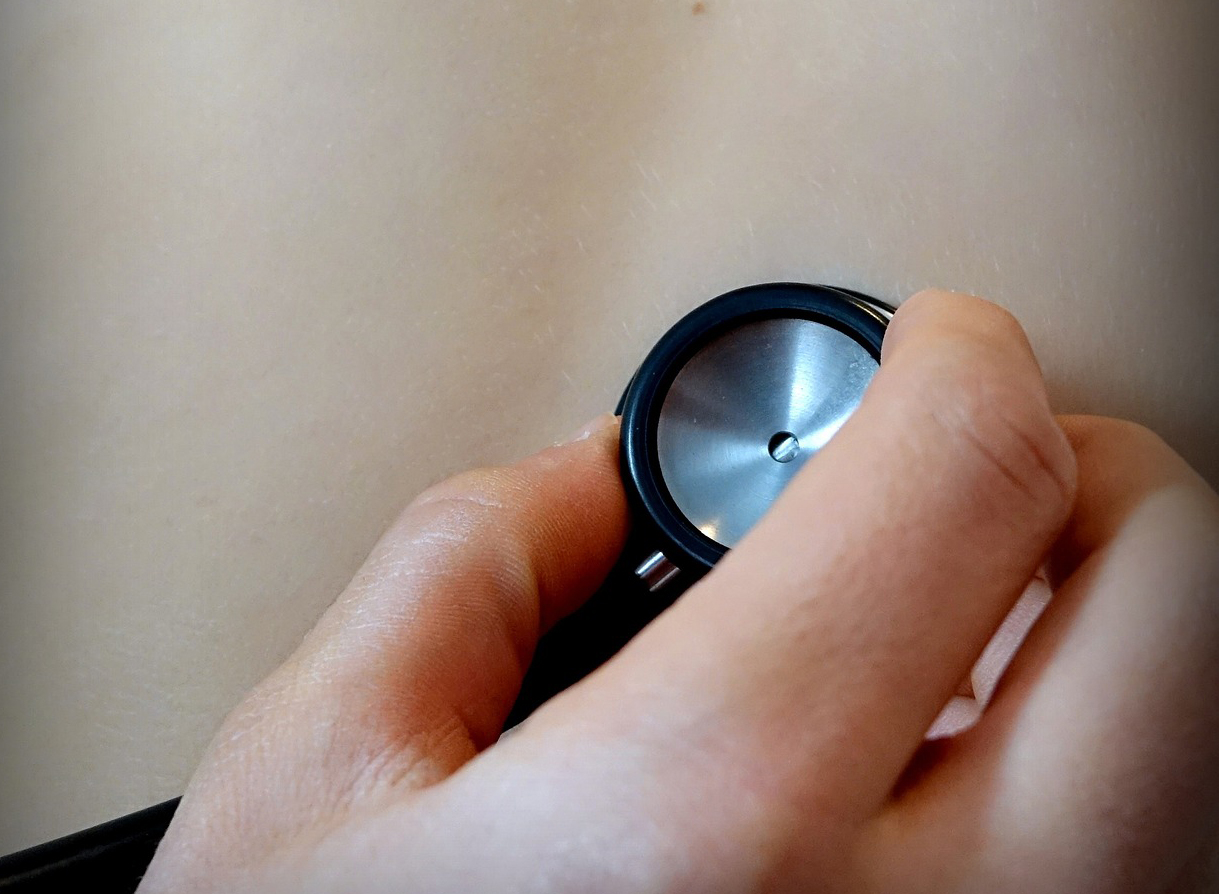Urgent Care
Diagnosis, treatment, and services for your everyday medical needs such as flu shots and lab work.

Nobody wants to spend hours sitting in a crowded emergency room, especially when you or your loved ones need immediate medical attention. At Chai Care, we understand that time is crucial when it comes to healthcare. That’s why we take pride in offering a quick, precise patient check-in and under-five-minutes wait time at our urgent care centers, providing a more efficient and convenient alternative to the Emergency Room.
The advantage of quick, precise patient check-in and under-five-minutes wait time at Chai Care’s urgent care centers offers a refreshing alternative to waiting for hours at the emergency room. Our commitment to efficient healthcare delivery, cutting-edge technology, and compassionate service ensures that you receive the timely care you need, without compromising on quality. Whether it’s a minor injury or a non-urgent illness, trust Chai Care to be your reliable partner in maintaining your health and well-being. Experience the convenience of fast care, less wait – because we value your time as much as we value your health.

In today’s fast-paced world, time is a precious commodity, especially when it comes to healthcare. At Chai Care, we understand the importance of providing quick and seamless medical services to our patients. Our meticulously organized clinical workflow is a reflection of our commitment to prioritize your health and well-being above all else.
Time is of the essence when it comes to medical care, and we believe that efficient healthcare not only improves patient experiences but also contributes to better health outcomes. That’s why our clinical workflow is designed to minimize waiting times and maximize your time with our expert healthcare providers.
From the moment you step into a Chai Care center, our streamlined processes ensure that you receive prompt attention. Our friendly front desk staff efficiently handle your check-in and insurance verification, so you can focus on what matters most – your health.
Our team of skilled nurses and medical assistants are trained to perform expert triage, quickly assessing your symptoms and medical history to prioritize your needs. This allows our physicians to attend to urgent cases promptly and efficiently.
Chai Care leverages cutting-edge medical technology to support our clinical workflow. Our state-of-the-art electronic health records (EHR) system enables seamless data sharing between healthcare providers, ensuring that your medical history is readily available to our team for accurate and comprehensive care.
We believe in the power of teamwork. Our interdisciplinary approach encourages collaboration between our healthcare experts, promoting better communication and informed decision-making. This results in a cohesive and efficient treatment plan that caters to your specific needs.
Efficiency does not mean compromising on compassion. At Chai Care, we infuse every step of our clinical workflow with genuine care and empathy. Our healthcare providers take the time to listen to your concerns, answer your questions, and ensure that you feel supported throughout your healthcare journey.
At the heart of our meticulous clinical workflow is a patient-centered approach. We value your time and understand that a seamless process contributes to a positive patient experience. By prioritizing efficiency, we aim to empower you to take charge of your health with ease and confidence.
The quick and seamless process of serving patients at Chai Care exemplifies our commitment to excellence in healthcare. From streamlined check-ins to collaborative treatment plans, our meticulously organized clinical workflow is designed to put you, the patient, first. We believe that efficiency and compassion can go hand in hand, and our team is dedicated to providing you with the highest standard of medical care in a warm and welcoming environment. Because at Chai Care, your well-being is our top priority, and we’re here to make a difference in your life, one efficient and caring step at a time.

Healthcare is the cornerstone of a thriving society, and at Chai Care, we firmly believe that it should be easy and accessible to everyone. We’re on a mission to bring efficient, top-quality medical care closer to your doorstep through our expanding array of local urgent care centers. Let’s explore how Chai Care is changing the game, one community at a time.
We understand that life can be unpredictable, and health issues can arise when you least expect them. That’s why we’ve carefully positioned our urgent care centers in various neighborhoods, ensuring that expert medical assistance is never far away. No more long drives or waiting in endless queues; Chai Care is just around the corner, ready to offer you the care you deserve.
What sets us apart is the meticulous approach we take in selecting our healthcare experts. Our team of skilled physicians, nurses, medical assistants, and X-ray techs are not only highly qualified, but they are also chosen for their compassion and empathy. When you step into a Chai Care center, you’ll be met with warm smiles and caring hearts, eager to put you at ease and address your health concerns.
Our urgent care centers are designed to cater to a wide range of medical needs, from treating minor injuries and illnesses to providing preventive care and vaccinations. Whether you’re seeking treatment for a sore throat, a sprained ankle, or just need a check-up, we’re here to support you every step of the way.
We believe that efficient healthcare goes hand in hand with advanced technology. That’s why we’ve integrated state-of-the-art medical equipment and digital systems into our centers. From quick and accurate X-ray results to electronic medical records, our streamlined processes ensure that you receive top-quality care promptly.
At Chai Care, we’re not just a healthcare provider; we’re a part of your community. We’re committed to creating a positive impact in the lives of our neighbors. By offering accessible healthcare, we empower you to take charge of your well-being and focus on what truly matters – your health and happiness.
So, my friend, the next time you need healthcare, remember that Chai Care is here for you. We’re dedicated to making top-quality medical care easy and accessible, right in your neighborhood. Together, let’s build a healthier and stronger community, one urgent care center at a time. Because at Chai Care, your well-being is our priority, and we’re here to make a difference.

In the fast-paced world of urgent care, every moment counts. When patients walk through our doors at Chai Care, they bring with them their worries, concerns, and health issues that need immediate attention. We understand the impact our care can have on their lives, and that’s why we go the extra mile to ensure they feel supported, comforted, and genuinely cared for throughout their visit. At the core of Chai Care’s philosophy is the belief that compassion and empathy are just as essential as medical expertise.
At Chai Care, we take great pride in our team of medical assistants, nurses, physicians’ assistants, and X-ray techs who are meticulously selected based on their caring attitudes and genuine empathy. Our staff understands that patients are not just medical cases, but individuals seeking comfort and understanding during their time of need. They are the heart and soul of our practice, embodying our commitment to providing comprehensive, high-quality medical care with a touch of compassion.
When patients enter our facility, they are met with warm smiles and attentive ears. Our medical professionals take the time to actively listen to their concerns, fears, and questions, making them feel valued and heard. This approach builds trust and eases anxiety, essential elements in delivering exceptional urgent care.
The impact of a caring attitude goes beyond comforting words and sympathetic gestures. Studies have shown that patients who feel genuinely cared for tend to have better health outcomes. When patients are met with empathy, their stress levels decrease, and they become more receptive to treatment and healing.
Moreover, genuine compassion fosters a deeper connection between the medical staff and the patients, creating an atmosphere of trust and mutual respect. Patients are more likely to openly share their symptoms and medical history when they feel understood and respected, enabling our medical professionals to make more accurate diagnoses and personalized treatment plans.
At Chai Care, we understand that each patient has unique circumstances and needs. Our medical professionals approach every case with open hearts and open minds, making sure to tailor their care to suit each individual. Whether it’s comforting a child during a vaccination or providing support to an anxious adult, our team is dedicated to easing the burden of illness or injury.
We encourage our staff to engage in ongoing training and education to enhance their empathy and communication skills continually. By fostering a culture of compassion within our organization, we empower our team to make a significant impact on patients’ lives every day.
At Chai Care, compassion is not an afterthought but an integral part of our medical practice. Our carefully chosen staff of medical assistants, nurses, physicians’ assistants, and X-ray techs embody this commitment, ensuring that every patient receives the highest level of care and support. Genuine compassion is not just a bonus; it is the driving force behind our mission to provide exceptional medical care that heals both the body and the soul.
We have countless daily examples of patients treated as humans, not just “problems to fix”.
Just yesterday, for example, little Emily came in for a vaccination at our Knickerbocker Ave. medical center, scared and uncertain. But our team was right there, holding her hand, and reassuring her with soothing words. Her frown turned into a smile, and the next time she visited, she was excited to see us! That’s the power of genuine care – turning fear into trust and anxiety into relief.
When David S. came in with a sprained ankle, our Hylan Boulevard medical center staff didn’t just treat the injury; they also lent a listening ear to his worries. They went above and beyond to make him feel at ease, reminding him that we were there for him every step of the way. He came in a little late in the evening, and our clinical staff stayed at work past closing time, called him an Uber and followed up the next day, to make sure his pain subsided and his well-being improved.
These are just two examples out of hundred per day, every day!
When patients step into Chai Care, they step into a caring community that believes in the power of empathy and genuine concern. With every interaction, we strive to make a positive impact, leaving our patients with a sense of comfort, healing, and hope.
Jan 03, 2023
Pneumonia and Bronchitis are two illnesses that can have many harmful effects. Unfortunately, when children contract it, they experience excoriating pain and if gone untreated, there can be grave consequences. It is important to stay informed and understand the signs of these viruses and illnesses to prevent your child from having any long-term consequences.
Pneumonia is a form of acute respiratory infection that affects the lungs. The lungs are made up of small sacs called alveoli, which fill with air when a healthy person breathes. When an individual has pneumonia, the alveoli are filled with pus and fluid, which makes breathing painful and limits oxygen intake.
Pneumonia is the single largest infectious cause of death in children worldwide. Pneumonia affects children and families everywhere and even though we have amazing healthcare options in our country, our youth is still very much at risk.
The presenting features of viral and bacterial pneumonia are similar. However, the symptoms of viral pneumonia may be more numerous than the symptoms of bacterial pneumonia. In children under 5 years of age who have a cough and/or difficulty breathing, with or without fever, pneumonia is diagnosed by the presence of either fast breathing or lower chest wall indrawing where their chest moves in or retracts during inhalation (in a healthy person, the chest expands during inhalation). Wheezing is more common in viral infections.
There are several ways Pneumonia can spread. The viruses and bacteria that are commonly found in a child’s nose or throat can infect the lungs if they are inhaled. They may also spread via air-borne droplets from a cough or sneeze. In addition, pneumonia may spread through blood, especially during and shortly after birth. More research needs to be done on the different pathogens causing pneumonia and the ways they are transmitted, as this is of critical importance for treatment and prevention.
While most healthy children can fight the infection with their natural defenses, children whose immune systems are compromised are at higher risk of developing pneumonia. A child’s immune system may be weakened by malnutrition or undernourishment, especially in infants who are not exclusively breastfed. Pre-existing illnesses, such as symptomatic HIV infections and measles, also increase a child’s risk of contracting pneumonia.
Pneumonia is caused by several infectious agents, including viruses, bacteria, and fungi. The most common is streptococcus which is the most common cause of bacterial pneumonia in children. Hemophilus influenza is the second most common cause of bacterial pneumonia, followed by the respiratory syncytial virus which is the most common viral cause of pneumonia.
Preventing pneumonia in children is an essential component of a strategy to reduce child mortality. Immunization against Hib, pneumococcus, measles, and whooping cough (pertussis) is the most effective way to prevent pneumonia. Adequate nutrition is key to improving children’s natural defenses, starting with exclusive breastfeeding for the first 6 months of life. In addition to being effective in preventing pneumonia, it also helps to reduce the length of the illness if a child does become ill. Addressing environmental factors such as indoor air pollution (by providing affordable clean indoor stoves, for example) and encouraging good hygiene in crowded homes also reduces the number of children who fall ill with pneumonia. In children infected with HIV, the antibiotic cotrimoxazole is given daily to decrease the risk of contracting pneumonia.
If your child’s symptoms are getting worse if he/she has a fever lasting for a few days, breathing problems, trouble drinking fluids, and new symptoms such as neck stiffness or swollen joints, it is time to call your child’s healthcare provider.
Now, it’s time to talk about Bronchitis. What is acute bronchitis in children? Bronchitis is an inflammation of the large breathing tubes in the lungs. The illness can be short-term (acute) or long-term (chronic). Acute bronchitis means that the symptoms often develop quickly and don’t last long. Most cases are mild.
Acute bronchitis is most often caused by a viral infection. It may also be caused by bacteria or things such as dust, allergens, strong fumes, or tobacco smoke. In children, the most common cause of acute bronchitis is a virus. The illness may develop after a cold or other viral infection in the nose, mouth, or throat (upper respiratory tract). Such illnesses can spread easily from direct contact with a person who is sick. Children that are more at risk for acute bronchitis are kids that deal with chronic sinusitis, allergies, asthma, enlarged tonsils and adenoids, and exposure to secondhand smoke.
Your child’s healthcare provider can often diagnose acute bronchitis with a health history and physical exam. In some cases, your child may need tests to rule out other health problems, such as pneumonia or asthma. These tests may include chest X-rays, pulse oximetry, or sputum and nasal discharge samples.
Treatment will vary depending on your child’s symptoms, age, and general health. It will also depend on how severe the condition is. In nearly all cases, antibiotics should not be used to treat acute bronchitis. That’s because most infections are caused by viruses. Even children who have been coughing for longer than 8 to 10 days often don’t need antibiotics.
It is important to talk with your child’s healthcare provider before giving over-the-counter cough and cold medicine to your child. Most experts do not recommend giving medication to children younger than four years old because it may cause harmful side effects. For children between ages four and six, only use over-the-counter products when recommended by your child’s healthcare provider. It is also important to note, not to give aspirin or medicine that contains aspirin to a child younger than age nineteen unless directed by your child’s provider. Taking aspirin can put your child at risk for Reye syndrome. This is a rare but very serious disorder. It most often affects the brain and the liver.
At the end of the day, pneumonia and bronchitis are two nasty illnesses that are brutal to deal with, but very much treatable. If your child finds themselves struggling with either one, self-care is an option, but Chai Care would be your best option for treatment because our incredible staff of trained experts will supply them with quality care while offering top-notch advice on how to stay healthy!
* Legal disclaimer: The content of this article and the entire Chai Care blog is for educational purposes only; it does NOT constitute medical advice and must not be considered as such. Please consult a medical professional regarding any symptoms or health concerns you or your loved ones.

Anyone unfortunate enough to have pink eye understands how painful and frustrating it is. Your eyes burn and the desire to itch the pain away becomes so unbearable that you’ll want to pluck your eyeballs right out. Worst still if the pink eye happens to your kid. This nasty infection is highly contagious and is the most common illness among children due to their lack of hygiene and not knowing who is infected. Your child will inevitably contract pink eye at some point, but there are plenty of ways to prevent and treat this obnoxious virus.
Pink eye is an infection that affects the covering of the eyeball and the inside of the eyelid. While it is usually caused by a virus, it can also be caused by bacteria. Infectious conjunctivitis — the kind that spreads from one person to another — is caused by bacteria, germs, and viruses. Often, the eye becomes infected when your child touches an infected surface and then rubs one of their eyes.
The infection causes the tiny blood vessels in the eye to dilate, resulting in the characteristic pink color. Because pink eye is so contagious, it can rapidly spread through a classroom or group of friends. Most cases of pink eye aren’t serious, but they still need to be treated by an eye doctor to help your child feel better and prevent the infection from getting worse.
Pink eye symptoms are rather easy to spot and trust me when I say, your child will be very verbal about it. The most common symptoms are having pink, red, swollen eyes, or discharge from the eyes, leaking from the eyes, crusty eyelids, lots of tears, and a scratchy, painful feeling in the eyes.
There are a few different ways your child may contract pink eye. Typically, it will be through direct contact. This is when a child with pinkeye touches the discharge from their eye and then touches another child. There is also indirect contact which is when an object that is contaminated with the virus, such as a tissue, is touched or touches another person’s eyes. Lastly, through droplets, this is caused by a common cold, droplets from a sneeze or cough can also spread it.
Most people believe that pink eye and conjunctivitis are one and the same. Yes, they are extremely similar to one another, however, conjunctivitis is slightly different.
Conjunctivitis can happen in one or both eyes. In addition to the pink appearance of your child’s eye, conjunctivitis can cause other symptoms that can help you and your eye doctor determine if conjunctivitis is the culprit. These include itching or burning, grittiness in the eye, discharge from the eye, crust along the eyelashes, and excess tearing. Even though the gritty feeling can be uncomfortable, conjunctivitis typically isn’t painful, nor does it cause blurry vision. If your child has these symptoms, they might have another eye issue, including a different type of infection.
Treatment of pink eye may involve antibiotic eye drops or ointment and will depend on the type of pinkeye. Purulent pinkeye, with a pink or red eyeball, white or yellow discharge, sticky or red eyelids, and eye discomfort, is usually caused by bacteria. It is treated with antibiotics, eye drops, or ointment, which stops the illness from spreading to others.
Non-purulent pinkeye, where the eyeball is pink or red, but the discharge is clear or watery, have range from only mild to no discomfort. It is usually caused by a virus or other irritant such as an allergy or exposure to a chemical like chlorine in a pool. An antibiotic drop will not work for this type of pinkeye.
Treatments for pink eye vary depending on the type. It could be caused by a viral or bacterial infection. Pink eye can also be caused by allergies, but the allergy-related pink eye isn’t contagious. Getting a proper diagnosis will help you get the best treatment for your child, while at-home treatments can help relieve uncomfortable symptoms.
Cold compresses are among the most effective at-home treatments for pink eye symptom relief. Use a separate compress for each eye and use a clean washcloth with each application. You can also clean your child’s eyes by wiping a tissue or similar material from the inner edge of the eye to the outer edge. Use clean material for each wipe so that nothing is rubbed back into the eye. Over-the-counter pink eye medicine like eye drops can help with itchiness and pain, and some are made with antihistamines for allergy-related pink eye.
Once conjunctivitis is diagnosed, treatment depends on what’s causing the infection. Applying warm or cool compresses to your child’s eyes can help relieve some of the itching or burning sensations. You can also help by gently cleaning the rims of your child’s eyelids, especially if your child has discharge from the eye. Lubricating eye drops may also be helpful.
Most cases clear up within a week. During that time, be sure your child washes their hands frequently with soap and warm water and remind them not to touch or rub their eyes. If your child wears contact lenses, have them wear glasses during the infection, and get rid of the lenses they were wearing when the infection began.
Fortunately, there are many ways your child can prevent themselves from contracting pink eye. To list a couple, wipe tears or discharge from your child’s eye from the inside out and in one direction only. Use a clean part of the cloth each time. Make sure they wash their hands and don’t share towels or washcloths because they could spread the illness. Lastly, if your child has viral pinkeye, they can return to childcare once they have seen a doctor. If your child has bacterial pinkeye and is taking antibiotics, they should stay home from childcare or school until they’ve had the antibiotics for 24 hours.
There is no need to panic at the sight of pink eye. However, if your baby has purulent eye discharge and is less than 3 months old, your child seems unwell and has a fever, rash, or eye pain, or if the pinkeye seems to keep coming back, then it is time to see your healthcare provider.
Although pink eye is incredibly painful, fortunately, it goes away quickly compared to other illnesses and rarely leads to something more serious. There are plenty of self-care options, but your best bet would be to take your child to Chai Care so one of our skilled experts can make a proper examination that will be quick and painless!
* Legal disclaimer: The content of this article and the entire Chai Care blog is for educational purposes only; it does NOT constitute medical advice and must not be considered as such. Please consult a medical professional regarding any symptoms or health concerns you or your loved ones.
Dec 27, 2022
No matter what season it is, allergies are inevitable. As frustrating as it may be, allergic reactions are a natural part of life even with all the medication and information we have in our modern world. Most allergies are not very harmful but understanding their nuances is an important thing to be aware of because they can lead to certain respiratory issues if gone untreated. This is most certainly the case with children because they are more likely than adults to not know the signs or ignore them due to their adolescent behavior. It’s up to you, the parent, to inform and protect your child from these pesky allergens so let’s explore the different types and symptoms that make your child sneeze, cough, and wheeze.
Allergies are abnormal immune system reactions to specific things that are usually harmless to most people. This causes symptoms that can range from minor to possibly life-threatening. Common allergens include certain foods, dust, plant pollen, and medicines.
If a child with an allergy is exposed to that allergen, their immune system mistakenly believes it’s harming their body. It overreacts, treating the substance as an invader, attempting to fight it off. The immune system makes antibodies called immunoglobulin E to protect the body. These cause certain cells to release chemicals into the bloodstream to defend against the allergen “invader”. It’s the release of these chemicals that causes allergic reactions. Reactions can affect the eyes, nose, throat, lungs, skin, and gastrointestinal tract. Future exposure to that same allergen will trigger this allergic response again.
There are different types of allergies that children may be exposed to. The first would be Airborne Allergies. This would include dust mites, pollen, molds, pets, and cockroaches.
The next would-be food allergies, this is especially common. Fish, eggs, cow’s milk, shellfish, tree nuts, soy, wheat, and sesame are all typical foods that a child may find themselves allergic to. Sometimes a child may have a small cough or light rash but in more serious cases a child can be so allergic to one of these foods that they may need to be rushed to the hospital. It is crucial to be aware of how allergic your child is to one or more of these foods to prevent serious consequences.
Other common allergies would be certain medications, an insect sting, bite, or chemicals. Some cosmetics or laundry detergents can make children break out in hives. Usually, this is because someone has a reaction to the chemicals in these products. Dyes, household cleaners, and pesticides also can cause allergic reactions in some children.
The tendency to develop allergies is often hereditary. They can be passed down through genes from parents to their kids. But just because a parent has allergies doesn’t mean that their kids will get them. And someone usually doesn’t inherit a particular allergy, just the likelihood of having allergies. Some kids have allergies even if no family member is allergic. Unfortunately, kids who are allergic to one thing often are allergic to others.
There are times when children will have cross-reactions. For example, children who are allergic to birch pollen might have symptoms when they eat an apple because that apple contains a protein like one in the pollen. And for reasons that aren’t clear, people with a latex allergy are more likely to be allergic to foods like kiwi, chestnuts, avocados, and bananas.
Some allergens may cause sneezing, a runny nose, itchy eyes and ears, and a sore throat. Other items on the list, such as foods, may cause hives (a red, bumpy, itchy skin rash), a stuffy nose, stomach cramps, vomiting, or diarrhea.
There are times when allergens can cause breathing problems like wheezing and shortness of breath. Some allergens, such as foods, are a problem all year long. But others might bother people only during certain seasons. For instance, you might be allergic to pollen from trees, which is present in the air only in the spring.
If your child sneezes and itches a lot, wheezes, or often gets sick after eating a certain food, they should get checked for allergies. They will ask your child many questions about their health, about the animals and plants in your home, and about the foods they eat. Your child’s answer will provide clues about what they might be allergic to, and the healthcare provider may ask them to stay away from a pet or stop eating a certain food to see if their symptoms go away.
The healthcare provider may send your youngster to an allergist, a special healthcare provider who helps people who have allergies. An allergist may give them a scratch test to see if a tiny bit of an allergen will cause a reaction on their skin. They will feel a quick pinch when the doctor makes the scratch or scratches. If they are allergic, one or more spots will become bumpy, itchy, and red.
Is it a cold or allergies? Both conditions can cause watery eyes, a runny nose, and sneezing. This may require some investigating to see which one you are experiencing, but if you take over-the-counter drugs and they don’t seem to be doing the trick, there is a good chance you have a cold and not an allergic reaction.
Many people mistake chronic hives for allergies. This is understandable as some allergic reactions cause hives, which are characterized by itchy patches of skin that turn into swollen red welts. Hives may be triggered by pet dander, foods such as cow’s milk, tree nuts, and shellfish, certain medications, or pollen, and tend to go away as the allergic symptoms are treated. However, chronic hives last for more than six weeks and may last months or years. If the cause cannot be identified even after a detailed history and testing, the condition is called chronic idiopathic urticaria. Chronic hives may also be associated with thyroid disease, other hormonal problems, or in very rare instances, cancer.
Eczema is a chronic, inflammatory skin condition, and although sufferers may develop asthma and sensitivities or allergies to foods and airborne allergens, eczema itself is not an allergy. However, the skin appears very dry and inflamed, resulting in a similar appearance to allergic contact dermatitis, which is a skin allergy that occurs when a person has exposure to a particular material.
A heat rash is often mistaken for an allergy. The best thing to do is avoid strenuous exercise when it is very warm, use air conditioning and fans in hot weather, take cool showers and baths, dry your skin thoroughly after bathing, wear lightweight, loose-fitting clothes, and drink plenty of fluids to cool the body and to keep hydrated.
If you regularly wake up with a dry throat and tired feeling, you might wonder if you have an allergy when the culprit could be sleep apnea. It is not age-specific, nor does it affect only overweight people. Signs of sleep apnea would be feeling unrefreshed after a full night’s sleep, frequent awakenings during the night, excessive daytime sleepiness or fatigue, being overweight, restless sleep, waking up with headaches, and nighttime acid reflux.
People often confuse food intolerance with a food allergy, but there’s a big difference. Food intolerance may often mimic a food allergy by causing nausea and vomiting, but it is not life-threatening. Children may experience symptoms such as diarrhea, constipation, abdominal pain, or fatigue. An intolerance is not an immune response, and the symptoms generally relate to stomach issues. While an intolerance to a food may make you miserable, a true food allergy can be potentially life-threatening.
Insect bites can sometimes mimic hives, a skin allergy that can occur in response to ingested allergens, so it’s easy for people to misdiagnose themselves. Like hives, insect bites may appear as raised, itchy bumps, either red or skin-colored.
Sadly, there is no cure for allergies, but symptoms can be managed. The best way to deal with them is to avoid allergens. You should speak to your kids often about the allergy itself and the reactions they can have if they consume or encounter the allergen. It is also important to tell your child’s teachers, family members, and parents of your child’s friends, about your child’s allergy.
If avoiding environmental allergens isn’t possible or doesn’t help, healthcare providers might prescribe medicines, including antihistamines, eye drops, and nasal sprays. In some cases, medical professionals recommend allergy shots to help desensitize a child to an allergen. But these are only helpful for allergens such as dust, mold, pollens, animals, and insect stings. They are not used for food allergies.
At some point, your child is going to experience the annoyance of allergies. It may be minor sniffling and coughing, or something more serious like a tree nut or shellfish allergy but nine out of ten times over-the-counter drugs or antibiotics will do the trick and if that doesn’t work the professionals at Chai Care can take a deeper look. Our trained staff is fully equipped to give a proper diagnosis and supply excellent advice so your child can live a proactive and healthy life!
* Legal disclaimer: The content of this article and the entire Chai Care blog is for educational purposes only; it does NOT constitute medical advice and must not be considered as such. Please consult a medical professional regarding any symptoms or health concerns you or your loved ones.

We can all recall a time when we as children had awful stomach pain or aches. Chances are you were hunched over, gripping your stomach in agony, claiming someone was stabbing your intestines with a knife. Dramatic and exaggerated, but when you’re a kid, everything is theatrical. Some of those incidents were no big deal. Just a minor cramp or nausea from eating too much candy before bed, but other times it may have been serious, so much so that medical attention was needed due to a parasite or appendicitis. Abdominal pain in children can vary from minor to major in the blink of an eye, which is why it is so important to be vigilant of the signs and symptoms.
If your child is experiencing stomach pain, it is most likely due to indigestion, constipation, stress, irritable bowel syndrome, appendicitis, or a stomach bug. These are the most common complaints that a child will have regarding stomach issues and fortunately, over counter drugs or a quick visit to your healthcare provider will help. However, stomach pain is more complicated than you might think. Depending on where the child is feeling the pain, this can change the diagnosis and the severity of the injury.
Stomach pain around the belly button is the most common complaint among children and in most cases, the least significant. The culprit of this discomfort is typically attributed to stress or eating something unagreeable. The best action to take for your child who is struggling with this would be to encourage them to rest, check to see if they need to poop, suggest drinking a glass of water, or offer a distraction of sorts. Reading a soothing story or playing a light-hearted game can take their mind off the pain and before they know it, they’ll forget all about it!
Pain in the lower right side of the abdomen can be much more serious, potentially hinting that your child may have appendicitis. Appendicitis is a serious medical emergency that can cause sudden, severe pain in the lower right part of your child’s stomach. If your child complains of stomach pain that moves to the lower right side of the belly, watch for other symptoms including fever, nausea, vomiting, difficulty passing gas, loss of appetite, constipation, and diarrhea. If you suspect that your child has appendicitis, contact your healthcare provider immediately. Early diagnosis decreases the risk of a ruptured appendix or serious complications.
If your child is complaining about pain on the left side of their stomach, it could be caused by constipation or a more severe condition like pancreatitis. Most of the time, stomach pain on the left side is due to something mild, like constipation. Rarely, it can be a sign of something more serious. Your child’s healthcare provider can work with you to better understand the pain and symptoms your child experiences to ensure they receive an accurate diagnosis.
If your child is complaining about pain in their upper abdomen, they may be experiencing indigestion. Telltale signs of indigestion include pain in the upper belly, nausea, bloating, burping, and heartburn. It is also worth mentioning that if your child has pain in the upper right side of their abdomen, this could also be a sign of gallstones. Gallstones are more common in adults than in children, but some children may be more at risk for developing gallstones, including children with obesity, children with certain health conditions including sickle cell disease, and children with a family history of gallstone disease.
This is a general term that describes discomfort in children’s upper abdomen. Common symptoms include pain or burning in the area between the breastbone and navel or bloating in the upper abdomen. Most of the time, indigestion will go away on its own and is not considered serious. Prepare smaller meals and try a bland diet. Talk with their healthcare provider if the discomfort persists.
This is an infection marked by watery diarrhea, abdominal cramps, pain, and nausea or vomiting. Seek medical attention if your child has a fever of 100.4 F or higher, bloody diarrhea, or significant pain or discomfort. The most important thing to do is to stay well-hydrated.
Constipated children have infrequent bowel movements or hard, dry stools. They may frequently complain of a stomachache, bloating, or discomfort. Talk with their primary care provider if they don’t want to eat, are losing weight, have bloody stools, or are having repeated episodes of constipation.
When children are stressed or anxious, their bodies release the hormone cortisol into the blood. This can trigger abdominal cramps and discomfort.
Appendicitis is an inflammation of the appendix. It causes sudden pain that begins around the navel and then moves to the lower right abdomen. The pain worsens if children cough, walk or make other jarring movements. Appendicitis pain typically increases and eventually becomes severe. Appendicitis is a medical emergency, and these children should receive immediate medical attention.
Appendicitis is one of the more common reasons your child may need surgery. The appendix is a small, dead-end tube leading from a part of the bowel. If this tube gets blocked, it can cause an infection. Appendicitis can happen at any age but is rare in young children.
The pain often starts in the middle of the tummy and moves down low on the right side. The stomach becomes sore to the touch. This is often worse with coughing and walking around. A child with appendicitis often shows signs of being unwell such as fever, refusing food, vomiting, or diarrhea.
If you are concerned your child may be developing appendicitis, visit your healthcare provider. An operation is often needed to remove the appendix, although in some cases the problem will settle without surgery.
Intestinal obstruction is a blockage that prevents food or liquid from passing through children’s small intestines or colon. It could be caused by scar tissue, a twisting or narrowing of the intestine, or if they swallow an object. Common symptoms include abdominal pain that comes and goes and is located around or below the navel, constipation, inability to pass gas, swelling of the abdomen, or vomiting. Seek immediate medical attention if children are suspected to have an intestinal obstruction.
Typically, when the problem is obvious there are no tests needed. However, if tests are needed, they may include blood or urine tests, stool samples, or other special tests for further examination. If your child does undergo tests, the healthcare provider should explain the results to you. Some results may take several days to come back, and these results will be sent to your primary care physician.
Stomach pain in children is usually nothing to worry about. But, if your child experiences any of the following symptoms, take your little one to their healthcare provider: diarrhea, pain when urinating, unexplained weight loss, jaundice, blood in stool, and recurrent stomach pain with no clear cause. From there, a medical professional can help you determine how severe the illness is.
Your child’s treatment will depend on what your healthcare provider determines is causing their pain. Treatment may be as simple as sending your child home with advice to rest, take fluids and eat a bland diet. Other treatment options include hospital admission and surgery. A few general suggestions would be to make sure your child gets plenty of rest and have them drink plenty of clear fluids such as cooled boiled water or juice. Do not push your child to eat if they feel unwell. If they are hungry, have them eat bland food like crackers or bananas and place a hot water bag on their stomach.
If your child doesn’t seem to be getting any better and their symptoms have manifested into more severe signs such as vomiting, blood in urine or stool, painful skin rash, fever, or chills, then you should take your child to Chai Care to have them checked out by our skilled medical professionals.
* Legal disclaimer: The content of this article and the entire Chai Care blog is for educational purposes only; it does NOT constitute medical advice and must not be considered as such. Please consult a medical professional regarding any symptoms or health concerns you or your loved ones may have.
Dec 15, 2022
“History will judge us by the difference we make in the everyday lives of children.” – Nelson Mandela.
Our obligation as adults is to protect our youth by any means necessary. The best way to do that is by staying informed about new scientific studies and taking advice from medical professionals on how to best help and nurture the children of the world. Because of their lack of knowledge and experience, toddlers depend on us to guide them through all the dangers and illnesses that may come their way. Even the safest and most responsible adults make mistakes now and again, which is why we are going to dive into everything you need to know about—”nursemaid’s elbow”.
When most people hear the words “nursemaid’s elbow” they are surprised to learn that it has anything to do with young children due to its strange name. In simple terms, nursemaid’s elbow occurs when the radius (one of the bones in the forearm) slides out of place from where it is normally attached to the elbow joint. It is a common condition in children younger than four years of age. Other names include pulled elbow, slipped elbow, or toddler’s elbow. The medical term for Nursemaid’s Elbow is “radial head subluxation”.
Let’s say you are out on the town, taking a leisurely stroll with your toddler. The youngster notices something that catches their eye, and they begin to run towards the excitement, when the parent grabs their arm to stop them, pulls too hard, and suddenly contracts the hand or forearm. This causes the radius to slip out of the ligament holding it into the elbow. It can also occur when an infant rolls himself or herself over, from a fall, or from pulling or swinging a young child by the hand. We all love picking up a baby and playing with them, but it’s important not to be too overzealous because the child is not fully developed to withstand such quick movements.
Nursemaid’s elbow is a tricky injury because it usually occurs to toddlers and young children who may not be able to articulate what exactly the problem is, leaving it up to the parent or guardian to figure it out. At first glance, nursemaid’s elbow may not be obvious and can easily go unnoticed, but the child will usually cry from the discomfort. Other important signs to look for would be: if the child avoids moving their arm below the shoulder, supports one arm with the other hand, holds their arm straight or slightly bent and close to the body, or if they refuse to rotate their palm.
In other words: if the child lacks mobility and demonstrates discomfort and flexibility in the arm, there is a good chance they are experiencing nursemaid’s elbow.
Now that you know the symptoms, the next question is:
The simple answer is: Yes.
Normal use of the arm will be painful and inhibited until the injury is corrected, which is why it is crucial to seek medical attention as soon as possible. There are certain cases where nursemaid’s elbow has corrected itself, but there is no reason to take that gamble, especially when dealing with children. Let your healthcare provider be the one to examine your child to make sure there are no fractures or breaks and once the examiner does that, they can begin the process of correcting the injury.
After your child has been officially diagnosed by your healthcare provider, they will perform a physical exam and ask a series of questions about what happened at the time of the injury. This physical exam will test your child’s range of motion and see if there is any tenderness at the elbow. The treatment is a simple, but effective physical maneuver called “nursemaid elbow reduction”. Lasting only a few seconds, the healthcare provider will perform the reduction by gently flexing and rotating the arm. If you hear a “pop” sound, don’t be alarmed! This is simply the joint moving back into place. As far as imaging tests are concerned, they often won’t show evidence of nursemaid’s elbow, however, an X-ray can be used to rule out a fracture or break.
Even though you should seek medical attention to have the joint corrected by a professional, there are forms of treatment you can do on your own. There are plenty of over-the-counter drugs to help your child manage the pain and applying ice to the injured area will also help. There are some adults out there who have attempted the correction maneuver themselves, this is not well advised.
Recovery begins immediately after your child’s elbow has been reduced. The best part is your child will only feel pain for a few seconds, but soon after will feel as good as new!
Now that you know what nursemaid’s elbow is and what signs to look for, let’s discuss a few simple ways to prevent this from happening. The best thing to do is avoid pulling or jerking your child by the arm or hand. This may sound simple, but when a child attempts to cross a street before looking both ways or their curiosity gravitates them to something that can harm them, your parental instincts kick in, telling you to pull them out of the way. Even though you are trying to protect them, you may actually hurt them in the process. Another method would be to use verbal cues instead of physical ones to get their attention and lastly, try not to swing your child around by the hands or arms for fun. Many parents do this because it’s entertaining and puts a smile on their child’s face, but this is probably the most common way children suffer from nursemaid’s elbow.
If the healthcare provider has successfully corrected the joint, nursemaid’s elbow should not come back but it is worth noting that a child who has had this injury is more likely to have it again, than someone who hasn’t. This is because the injury stretches the ligaments, making it harder to hold the bone in place. A child who has experienced Nursemaid’s Elbow may have looser ligaments in general too. Fortunately, as children grow, their bones and ligaments will become stronger, making nursemaid’s elbow highly unlikely after a child turns five years old.
We are privileged to live in a country where we have countless urgent care facilities that are staffed with exceptional medical professionals who can easily help if your child experiences nursemaid’s elbow. This is an injury that should not go un-diagnosed and luckily for you, Chai Care will always be here to supply you with the top-notch service and sensitive care that your child deserves!
* Legal disclaimer: The content of this article and the entire Chai Care blog is for educational purposes only; it does NOT constitute medical advice and must not be considered as such. Please consult a medical professional regarding any symptoms or health concerns you or your loved ones.

It is no secret that children are the most vulnerable people on the planet. Because of their youth and lack of experience, our moral responsibility as adults is to make sure that we are well-informed about various medical emergencies. We can almost expect that there will come a time when we will need to see the signs or symptoms of any minor or serious injuries that a child may experience. Of course, a medical professional will be the one who calls the final shots. However, before seeing a healthcare provider, you, as the parent, will be the one to notice if your son or daughter is experiencing something out of the ordinary. One common injury a child can endure is the development of an abscess.
Painful and warm to the touch, abscesses can virtually show up anywhere on your body. However, the most common sites are in the armpits, areas around the anus and vagina, the base of the spine, around a tooth, and in the groin. It’s also important to note that inflammation around a hair follicle can also lead to the formation of an abscess, which is called a boil.
Unlike other infections, antibiotics alone will not usually cure an abscess. In general, an abscess must be opened and drained for it to improve. Sometimes draining occurs on its own, but generally, it must be opened with the help of a warm compress or by a doctor in a procedure called ‘Incision and Drainage.’
Sadly, kids are more prone to abscesses because they’re less likely to tend and clean their wounds, putting them at risk for these nasty infections. Foreign objects that get inside a wound, like sand or clothing fibers, can also lead to abscesses, as can irritated hair follicles.
The first kind of abscess we’ll discuss is skin abscesses. This is when bacteria get under the surface of your skin, and an abscess forms. This can occur anywhere on the body, although skin abscesses tend to be more common in the underarms, genitals, buttocks, trunk, hands, and feet. When this happens, bacteria will creep underneath your skin and cause an abscess. If you have a minor skin wound, such as a small cut, gash, or a sebaceous gland (oil gland) or sweat gland, this can lead to an abscess as well.
Then there are internal abscesses. These develop inside of the stomach and are caused by an infection reaching tissue deeper within the body. This can occur because of an injury, abdominal surgery, or an infection spreading from a nearby wound or cut. Unfortunately, there are numerous ways an infection can spread in the abdomen and cause an abscess to develop. For example, a lung abscess may form after a bacterial infection in your lungs, such as pneumonia, and a burst appendix can spread bacteria within your abdomen. If your child is experiencing high temperature, increased sweating, chills, pain in their stomach, or loss of appetite and weight, your child may be experiencing an internal abscess.
Lastly, there are tooth abscesses. This is when a pocket of pus that’s caused by a bacterial infection poison one of your teeth. The abscess can occur in different areas near the tooth for different reasons. A periapical abscess occurs at the tip of the root. A periodontal abscess occurs in the gums at the side of a tooth root. A periapical tooth abscess usually occurs because of an untreated dental cavity, an injury, or prior dental work. The resulting infection with irritation and swelling can cause an abscess at the tip of the root. Symptoms to look out for are severe toothaches that spread to the jawbone, neck, and ear, pain with hot and cold temperatures, pain when chewing, fever, swelling in the face, tender or swollen lymph nodes, and foul mouth odor.
Traditionally, dentists will treat a tooth abscess by draining it and getting rid of the infection. They may be able to save your tooth with a root canal treatment. But in some cases, the tooth may need to be pulled. Leaving a tooth abscess untreated can lead to serious, even life-threatening, complications so make sure to take your little one to the dentist ASAP!
The most common way someone may contract an abscess is from infection with staphylococcal bacteria. From there, bacteria enter the body, and the immune system sends white blood cells to fight the infection. This causes swelling at the site of infection and the death of nearby tissue. A cavity is created, which fills with pus to form an abscess. The pus contains a mixture of dead tissue, white blood cells, and bacteria. The abscess may get larger and more painful as the infection continues and more pus is produced. Some types of staphylococcal bacteria produce a toxin called Panton-Valentine leucocidin, which kills white blood cells. This causes the body to make more cells to keep fighting the infection and can lead to repeated skin infections. However, in rare cases, an abscess may be caused by a virus, fungi, or parasites.
Finally, some good news! Most abscesses can be treated at home. If the abscess is small (less than 1 cm or less than a half-inch across), applying warm compresses to the area for about 30 minutes 4 times daily may help. Do not attempt to drain the abscess by squeezing or pressing on it. This can push the infected material into the deeper tissues. Also, do not attempt to stick a needle or other sharp instruments into the abscess center, because you may injure an underlying blood vessel or cause the infection to spread. It’s important to make sure your child avoids touching, pushing, popping, or squeezing the abscess because that can easily spread the infection or push it deeper inside the body, only making things worse. An easy way to prevent spreading the infection is by not letting your child share clothes, towels, washcloths, sheets, or anything that may have touched the abscess.
Even though you can take it upon yourself to treat your little one, seeing a healthcare provider is highly recommended to ensure full safety. The trained professional will be skilled enough to cut open the abscess and completely drain the pus and debris. Once the sore has drained, the doctor may insert some packing into the remaining cavity to allow the infection to continue to drain. It may be kept open for a day or two. A bandage will then be placed over the packing, and you will be given instructions about home care. Most children will feel better immediately after the abscess is drained. If the child is still experiencing pain, the doctor may prescribe antibiotics for home use over the next few days.
Continuing on the good news train, abscesses of all kinds can be prevented by practicing good hygiene. Keep all cuts and wounds clean, dry, and covered with a bandage to protect them from germs. It is also important to teach kids to wash their hands often and well, using soap and water for at least 20 seconds. If soap and water aren’t handy, it’s OK to use alcohol-based instant hand sanitizers or wipes.
Fortunately, once treated the abscess should heal and your child will forget all about it. Even though there are rare cases in which abscesses shave led to serious illnesses, the chances of that happening are extremely low if you make sure to follow these simple steps. Abscesses can be nasty, and many people become squeamish at the sight of them, but the staff at Chai Care are trained professionals who can take care of them in no time!
* Legal disclaimer: The content of this article and the entire Chai Care blog is for educational purposes only; it does NOT constitute medical advice and must not be considered as such. Please consult a medical professional regarding any symptoms or health concerns you or your loved ones.